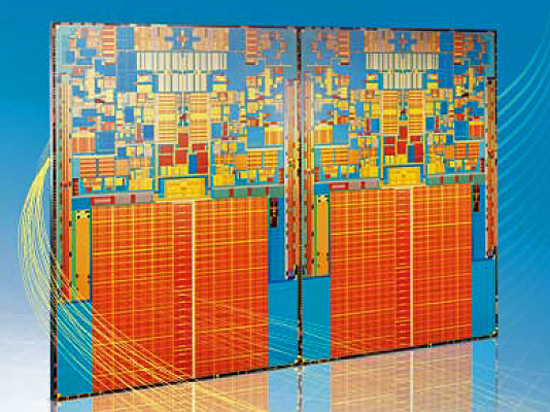Intel's Larrabee Architecture Disclosure: A Calculated First Move
by Anand Lal Shimpi & Derek Wilson on August 4, 2008 12:00 AM EST- Posted in
- GPUs
Introduction
Oooh this is dangerous.
It started with Intel quietly (but not too quietly) informing many in the industry of its plans to enter the graphics market with something called Larrabee.
NVIDIA responded by quietly (but not too quietly) criticizing the nonexistant Larrabee.
What we've seen for the past several months has been little more than jabs thrown back and forth, admittedly with NVIDIA being a little more public with its swings. Today is a big day, without discussing competing architectures, Intel is publicly unveiling, for the first time, the basis of its Larrabee GPU architecture.

Well, it is important to keep in mind that this is first and foremost NOT a GPU. It's a CPU. A many-core CPU that is optimized for data-parallel processing. What's the difference? Well, there is very little fixed function hardware, and the hardware is targeted to run general purpose code as easily as possible. The bottom lines is that Intel can make this very wide many-core CPU look like a GPU by implementing software libraries to handle DirectX and OpenGL.
It's not quite emulating a GPU as it is directly implementing functionality on a data-parallel CPU that would normally be done on dedicated hardware. And developers will not be limited to just DirectX and OpenGL: this hardware can take pure software renderers and run them as if the hardware was designed specifically for that code.
There is quite a bit here, so let's just jump right in.










101 Comments
View All Comments
Shinei - Monday, August 4, 2008 - link
Some competition might do nVidia good--if Larrabee manages to outperform nvidia, you know nvidia will go berserk and release another hammer like the NV40 after R3x0 spanked them for a year.Maybe we'll start seeing those price/performance gains we've been spoiled with until ATI/AMD decided to stop being competitive.
Overall, this can only mean good things, even if Larrabee itself ultimately fails.
Griswold - Monday, August 4, 2008 - link
Wake-up call dumbo. AMD just started to mop the floor with nvidias products as far as price/performance goes.watersb - Monday, August 4, 2008 - link
great article!You compare the Larrabee to a Core 2 duo - for SIMD instructions, you multiplied by a (hypothetical) 10 cores to show Larrabee at 160 SIMD instructions per clock (IPC). But you show non-vector IPC as 2.
For a 10-core Larrabee, shouldn't that be x10 as well? For 20 scalar IPC
Adamv1 - Monday, August 4, 2008 - link
I know Intel has been working on Ray Tracing and I'm really curious how this is going to fit into the picture.From what i remember Ray Tracing is a highly parallel and scales quite well with more cores and they were talking about introducing it on 8 core processors, it seems to me this would be a great platform to try it on.
SuperGee - Thursday, August 7, 2008 - link
How it fit's.GPU from ATI and nV are called HArdware renderers. Stil a lot of fixed funtion. Rops TMU blender rasterizer etc. And unified shader are on the evolution to get more general purpouse. But they aren't fully GP.
This larrabee a exotic X86 massive multi core. Will act as just like a Multicore CPU. But optimised for GPU task and deployed as GPU.
So iNTel use a Software renderer and wil first emulate DirectX/OpenGL on it with its drivers.
Like nv ATI is more HAL with as backup HEL
Where Larrabee is pure HEL. But it's parralel power wil boost Software method as it is just like a large bunch of X86 cores.
HEL wil runs fast, as if it was 'HAL' with LArrabee. Because the software computing power for such task are avaible with it.
What this means is that as a GFX engine developer you got full freedom if you going to use larrabee directly.
Like they say first with a DirectX/openGL driver. Later with also a CPU driver where it can be easy target directly. thus like GPGPU task. but larrabee could pop up as extra cores in windows.
This means, because whatever you do is like a software solution.
You can make a software rendere on Ratracing method, but also a Voxel engine could be done to. But this software rendere will be accelerated bij the larrabee massive multicore CPU with could do GPU stuf also very good. But will boost any software renderer. Offcourse it must be full optimised for larrabee to get the most out of it. using those vector units and X86 larrabee extention.
Novalogic could use this to, for there Voxel game engine back in the day's of PIII.
It could accelerate any software renderer wich depend heavily on parralel computing.
icrf - Monday, August 4, 2008 - link
Since I don't play many games anymore, that aspect of Larrabee doesn't interest me any more than making economies of scale so I can buy one cheap. I'm very interested in seeing how well something like POV-Ray or an H.264 encoder can be implemented, and what kind of speed increase it'd see. Sure, these things could be implemented on current GPUs through Cuda/CTM, but that's such an different kind of task, it's not at all quick or easy. If it's significantly simpler, we'd actually see software sooner that supports it.cyberserf - Monday, August 4, 2008 - link
one word: MATROXGuuts - Monday, August 4, 2008 - link
You're going to have to use more than one word, sorry... I have no idea what in this article has anything to do with Matrox.phaxmohdem - Monday, August 4, 2008 - link
What you mean you DON'T have a Parhelia card in your PC? WTF is wrong with you?TonyB - Monday, August 4, 2008 - link
but can it play crysis?!